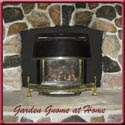In a previous post I spoke of Clematis, a beautiful flowering vine. This is one vine my husband will let climb on the side of the house. It does not damage the siding or motar like English Ivy or Trumpet vine. Clematis does need to be supported usually by some type of trellising system. I had two clematis growing at our old house. One was transplanted from the house before and one was planted from a nursery potting. Neither did well until this past year so I was saddened to leave them behind. I took a few clippings without much luck so was quite pleased to find a blooming clematis between the archways of our covered patio.
Clematis comes in a wide range of colours and flower shapes and sizes. My experience is this vine takes a year or two to start growing nicely after transplanting. It likes cold feet and a warm body meaning that the roots should be shaded while the vining growth does well in the sun. They are tolerant to pruning but improper pruning will result in fewer blooms. My clematis has never really needed pruning but I suspect this more mature vine will need it. More about pruning can be found here.
Clematis can experience clematis wilt usually due to damaging the younger stems. A fungus, (Ascochyta clematidina, most common) can attack the damaged area causing wilting. The best remedy for this is to prune out the damaged area to 1-inch below the infected area. Mildew can also affect Clematis later in the season. This is more problematic for plants in areas without good air circulation.
The most common pests of clematis are earwigs ( Forficula auricularia) and slugs. Slugs attack the early shoots while earwigs attack the later blooms. Both should be controlled to prevent damage and in the case of earwigs an indoor infestation. This can be quite a problem when clematis is growing along the outside wall of a house and there are ground level windows as in our house. Slugs can be controlled using commercial slug bait (not my choice), homemade slug traps or manual removal. Earwigs while they damage the flowers are even more of a problem indoors where they will settle into anything damp. They do cause damage to the blooms they are a nuisance indoors. Control using a manual removal method is best. Roll up a wet newspaper and leave overnight as a trap. In the morning carefully pick up the newspaper and shake the earwigs into a bucket of soapy water. This method works well indoors or outdoors.
Happy Gardening!
Garden Gnome
©2007






 Solar Lighting
Solar Lighting



















